Key takeaways:
- Creating a safe space for women to express health concerns is crucial for effective advocacy.
- Forming alliances amplifies impact and fosters innovative solutions in tackling women’s health issues.
- Open communication and transparency among partners enhance collaboration and trust.
- Listening to community voices and celebrating small victories are essential for sustaining advocacy efforts.
Understanding women’s health advocacy
Women’s health advocacy is about amplifying the voices of those who often go unheard. I recall a time when I volunteered at a local clinic and saw firsthand how women would often hesitate to speak about their needs. This experience made me realize that the first step in advocacy is creating a safe space for women to express their health concerns openly. Have you ever wondered what obstacles prevent women from seeking help?
Understanding women’s health means considering not just the physical aspects, but the emotional and social challenges that accompany health issues. For example, I once spoke with a mother who felt isolated and overwhelmed by her mental health struggles. It struck me how vital it is for advocacy to address the intersectionality of gender, race, and socioeconomic status in health care. How can we ensure that every woman, regardless of her background, has access to the resources she needs?
Furthermore, effective advocacy requires collaboration across various sectors. I had the opportunity to partner with a local organization focused on reproductive rights, and the impact was profound. Through our combined efforts, we educated over a hundred women about their choices and rights. It made me think: What if each community could come together in such a way to transform women’s health landscape? That’s the power of advocacy.
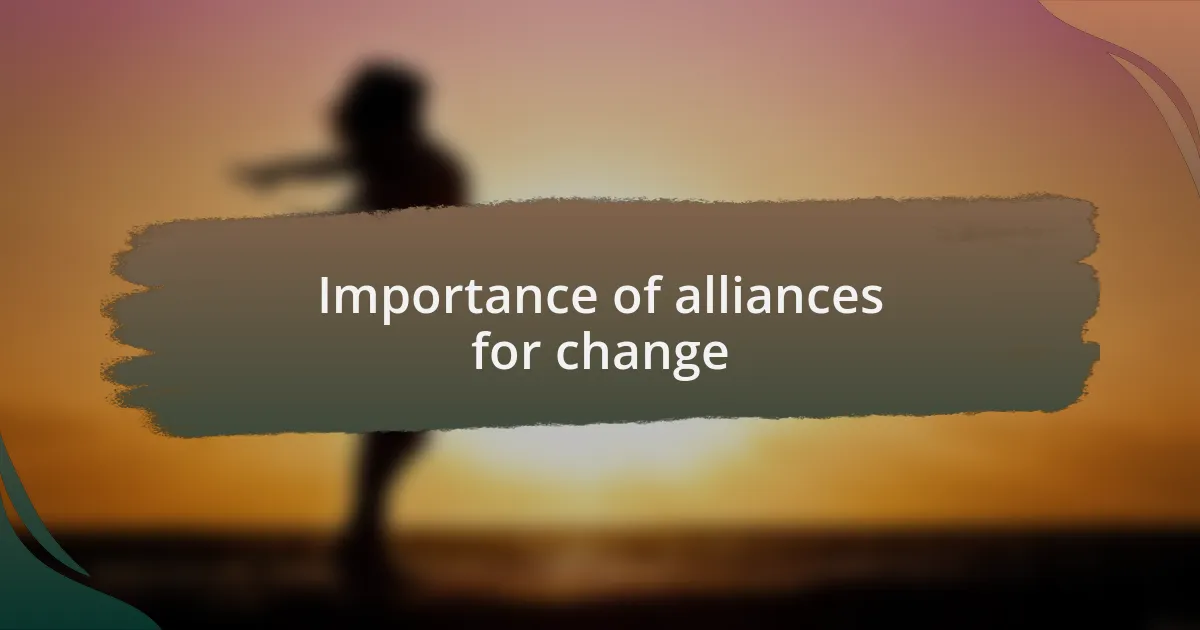
Importance of alliances for change
Alliances are essential for driving social change, especially in women’s health advocacy. I remember the first time I collaborated with a diverse group of advocates from different backgrounds. We quickly realized that by combining our experiences and resources, we could tackle issues on a larger scale than we ever could alone. Have you considered how much more impactful a united front can be when addressing complex topics like reproductive health?
In my journey, forming alliances often led to unexpected but powerful outcomes. For instance, when I teamed up with mental health organizations, we created a holistic program that addressed both physical and emotional wellness for women in our community. The benefits of pooling resources and knowledge were undeniable, as we saw an increase in women seeking support. It’s a reminder that when we come together, our collective voice resonates louder, haunting the corners where stigma and silence usually thrive.
Moreover, alliances can foster innovation and new ideas. One initiative I was involved in started with a brainstorming session among several groups. What emerged was a mentorship program that linked younger women with experienced health advocates. This initiative not only built community trust but also empowered the next generation to take charge of their health. Isn’t it intriguing how a simple collaboration can spark a movement? The potential is limitless when we leverage our shared strengths for a common cause.
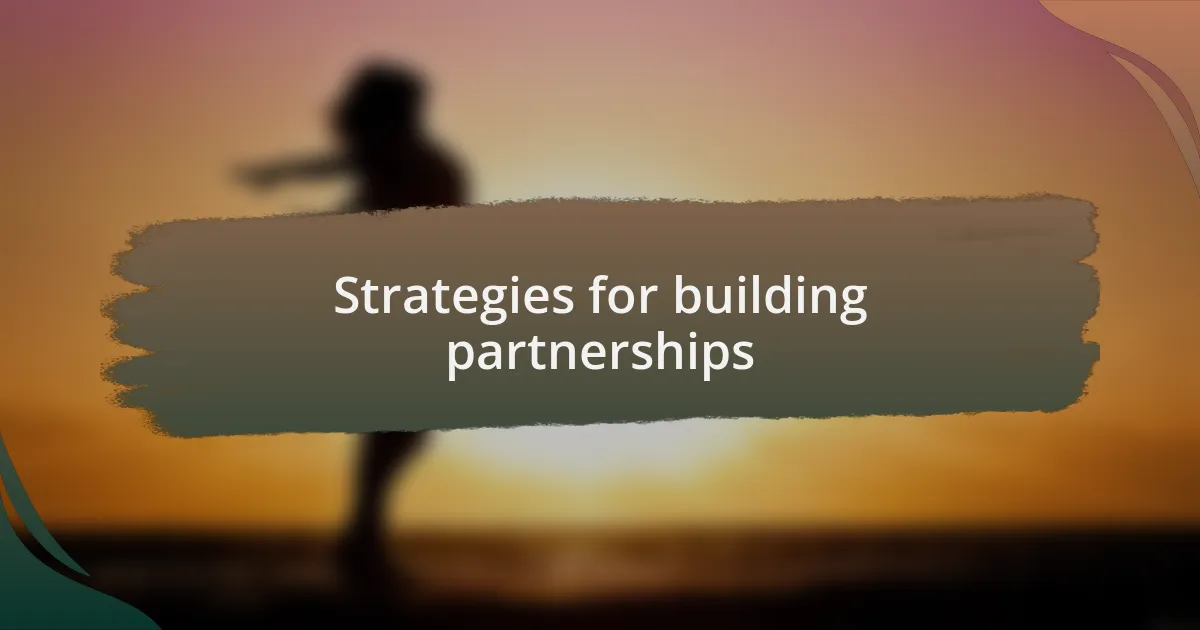
Strategies for building partnerships
Building partnerships requires a strategic approach that focuses on shared goals and mutual respect. One effective strategy I discovered was to host small gatherings with key stakeholders. During these meetings, we’d share our visions, challenges, and resources, fostering genuine connections. I can still recall a moment when a local healthcare provider shared their frustrations about systemic barriers; this opened the door for collaboration that addressed not only their needs but also the broader issues impacting women’s health in our community.
Additionally, it’s crucial to communicate openly and honestly from the start. I remember a partnership that struggled initially due to differing expectations. Once we established a transparent dialogue, we were able to redefine our objectives together. This experience highlighted how essential ongoing communication is in sustaining partnerships. Have you ever experienced a misunderstanding that could have been avoided with clearer conversations? I’ve found that when partners are aligned, everyone benefits.
Another strategy is to celebrate small victories together. After launching a joint initiative focused on prenatal care, we took a moment to acknowledge each partner’s contributions in a community event. Seeing community members respond positively to our efforts was not just a win for us; it was a reminder of how alliances amplify impact. Reflecting on these shared successes fosters a sense of ownership and motivates everyone to continue pushing for change. What achievements have you celebrated that fortified your partnerships? Sharing those moments creates a stronger bond and fuels future collaborative efforts.
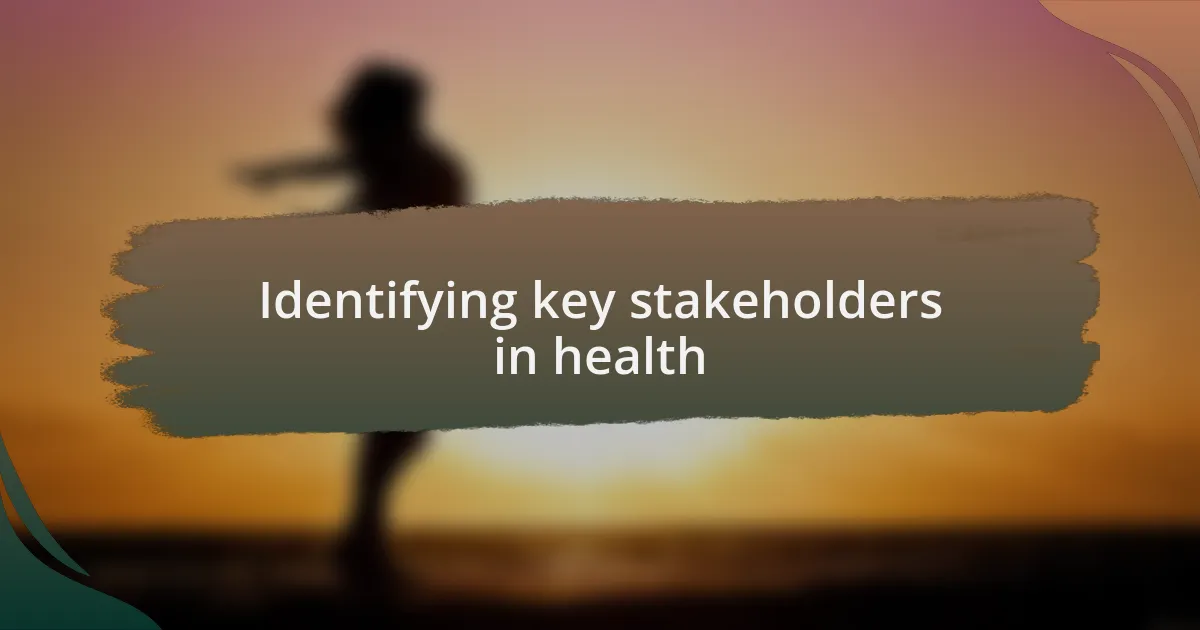
Identifying key stakeholders in health
Identifying key stakeholders in health begins with understanding who holds the power to effect change. In my experience, this involves mapping out the various entities involved in women’s health—be it governmental bodies, healthcare providers, non-profit organizations, or patient advocacy groups. One memorable instance was when I connected with a local women’s shelter that had a wealth of knowledge about the specific barriers their clients faced. Their insights not only enriched my perspective but also laid the groundwork for a robust partnership.
One vital consideration when pinpointing these stakeholders is recognizing the diverse perspectives they bring to the table. Each stakeholder may have different motivations and goals. For example, while clinicians focus on immediate patient care, policymakers might concentrate on broader health initiatives. I recall facilitating a focus group where a community health worker emphasized the need for culturally competent care. That moment illuminated how essential it is to incorporate voices from all levels. How often have you sat in a meeting and realized that a single comment could reshape the entire approach? It’s those insights that can transform initiatives.
Furthermore, building relationships with stakeholders involves nurturing trust and demonstrating value. I learned this firsthand while working with a coalition that included local government officials. Initially, they were skeptical about our plans. After sharing data on health disparities and inviting them to community forums, they began to see the impact of our work. Their eventual support was pivotal in securing funding for essential health programs. Have you ever seen a relationship blossom through transparency and collaboration? It’s a powerful reminder of how genuine engagement can foster collective action for change.
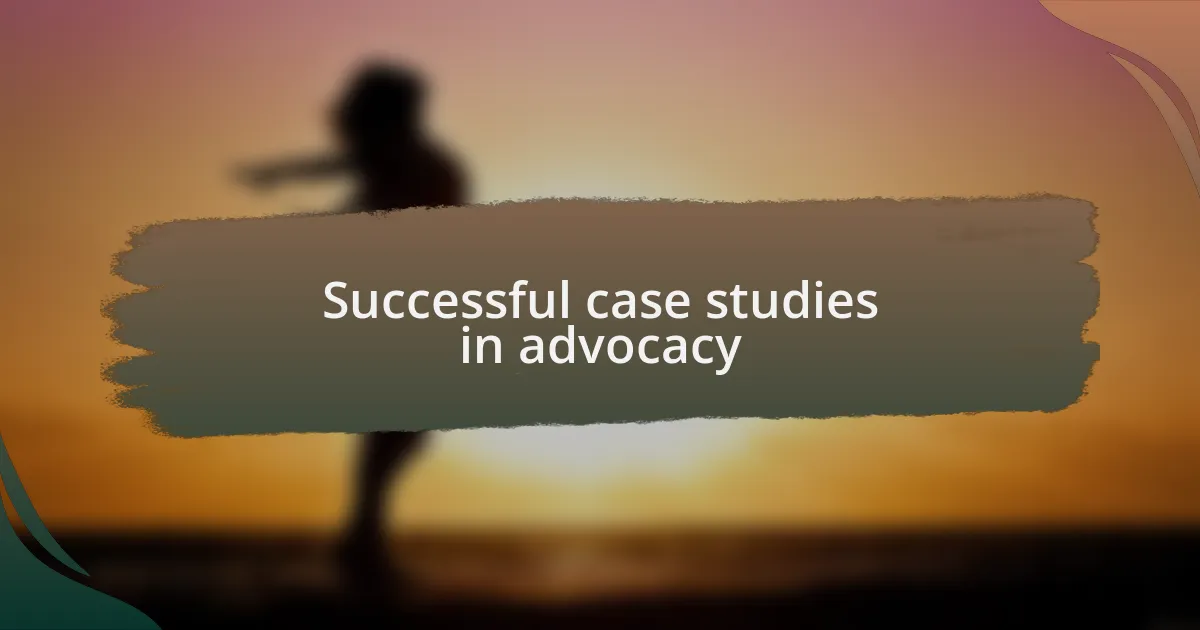
Successful case studies in advocacy
One standout case study in advocacy that resonates with me is the collaborative effort of a women’s health organization that partnered with local universities to address maternal mortality rates. They not only organized awareness campaigns but also involved students in research projects that highlighted underlying social determinants. Witnessing young advocates stepping up and owning their research was inspiring—it felt like the next generation was doing their part for women’s health. Have you ever experienced that rush of hope when fresh ideas and passionate minds come together for a cause?
Another compelling example is a grassroots initiative that united various community leaders to tackle mental health stigma in women. This coalition hosted events that shared personal stories and provided educational resources. I remember attending one event where a participant bravely shared her journey through postpartum depression. The raw honesty created a safe space for others to open up, and that’s when I realized—advocacy isn’t just about policy; it’s about humanity. How often do we underestimate the power of vulnerability in sparking change?
A particularly impactful case was when a network of women’s health advocates lobbied for legislative change to improve access to contraceptive services. Collaborating with legal experts allowed them to draft a comprehensive policy proposal. I vividly recall the moment they presented their findings at a state capitol hearing. The palpable energy in that room, filled with advocates passionately fighting for their rights, was electric. It reminds me of the importance of blending passion with knowledge for effective advocacy. Have you ever felt that surge of determination while standing up for something you deeply believe in?
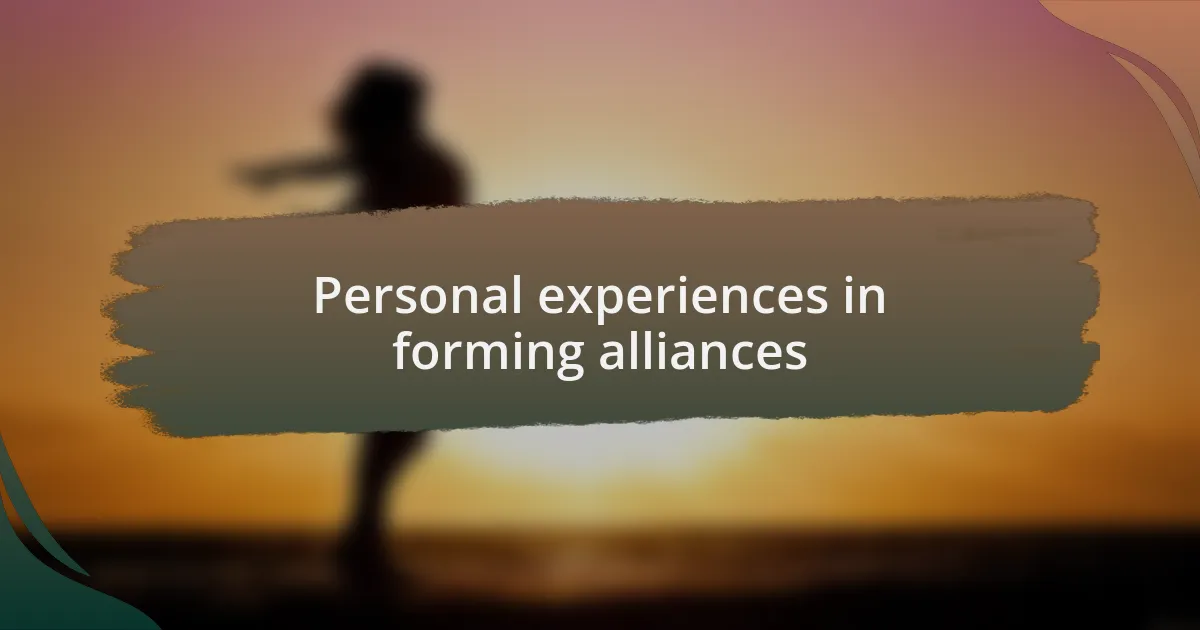
Personal experiences in forming alliances
I remember my first attempt at forming an alliance when I approached a local non-profit focused on women’s health. Initially, I felt nervous, questioning whether my ideas were valid enough to resonate with them. However, during our first meeting, their openness and willingness to collaborate turned my uncertainty into excitement. It was a pivotal moment for me, highlighting that alliances are built on shared vision and respect. Have you ever taken that leap and discovered newfound confidence in unexpected places?
There was a time I attended a conference where I met a group of passionate young women who were just as committed to health equity as I was. As we shared our individual experiences, the synergy was palpable. We started a small support network, exchanging resources and strategies that made our advocacy efforts more effective. I learned that the exchange of ideas is invaluable; it often leads to innovative solutions. How rewarding is it to find that your experiences can resonate with and inspire others on the same journey?
On another occasion, I collaborated with healthcare professionals who specialized in maternal health. We organized a series of workshops aimed at educating underserved communities. The energy in the room was transformative. During one session, a healthcare worker shared her own struggles with the system, and I could see participants leaning in, their faces lit with recognition. It struck me then that alliances bring together diverse voices that can amplify the narrative for change. Don’t we all yearn for a community that speaks to our truths?

Lessons learned from advocacy efforts
Throughout my advocacy journey, one of the most important lessons I’ve learned is the significance of listening. In a community meeting, as I shared our initiative aimed at improving women’s health resources, I felt the room shift when several members voiced their own concerns and expectations. Their insights reframed my understanding, and I realized that creating lasting alliances often hinges on our ability to hear others fully. Can you recall a time when listening changed the direction of a conversation for you?
Another lesson emerged from a project we launched collaboratively. Initially, I assumed that everyone had the same vision and resources. However, as we progressed, I discovered disparities in commitment and capacity among partners. It taught me that transparency is essential; being upfront about limitations fosters trust and sets realistic expectations. Have you ever faced a situation where assumptions led to misunderstandings in a partnership?
Lastly, I learned that celebrating small victories can be incredibly motivating for everyone involved. After securing funding for a local health campaign, we all gathered to reflect on our progress and share our experiences. This moment of recognition fueled our collective spirit, reminding us that every step counts in advocacy work. Have you taken the time to acknowledge progress, no matter how small? It can make a world of difference.